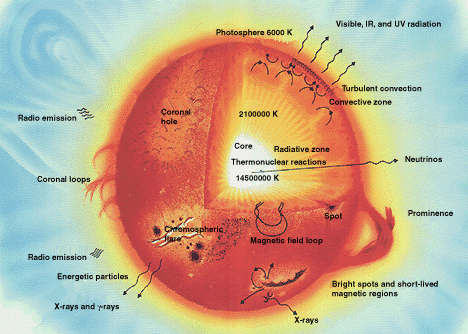Most of the small twinkling lights in the sky at night are stars so far away from the Earth that you would never be able to get to them even if you travel at the speed of light (300 000m/s) for your entire life! The closest star to our planet is only 150 million kilometers away (this is considered a short distance in space) and is known simply as the “Sun.” Without the Sun, life on Earth would not exist. It is essential for providing life with energy by powering plants (they then perform photosynthesis to create food). All stars function similarly to the Sun. All stars have a “life cycle” where new stars are constantly being “born” and old stars “die.” Our Sun is in the middle of its “life;” it is approximately 5 billion years old and will exist for another 5 billion years. All of the energy produced by stars comes from the fuel that is in them – atoms of hydrogen. Hydrogen atoms undergo a process called “nuclear fusion.” Nuclear fusion is when 2 atoms of hydrogen fuse (join) together to form an atom of helium (He). The star dies once it runs out of hydrogen atoms.
A CLOSE LOOK AT THE SUN
Astronomers have discovered a lot about the Sun through careful observations (NEVER look through a telescope at the Sun! It will blind you permanently) and by space probes sent near the Sun. The Sun appears as follows:
At the center of the Sun is the “core.” This is the site of nuclear fusion and scientists estimate temperatures reach 15 million degrees Celsius here. Surrounding the core are moving gases (mostly hydrogen and helium). The surface of the Sun is known as the “photosphere.” It is not a solid surface and is estimated to be at a temperature of 5500oC. The inner atmosphere surrounding the photosphere is known as the “chromosphere.” Beyond the chromosphere is the outer atmosphere layer, which is known as the “corona.” The corona is estimated to be at a temperature of 1 million degrees Celsius.
THE SUN’S EFFECTS ON EARTH
From both the chromosphere and the corona, bursts of energy known as solar flares (smaller) and solar prominences (larger) occur. Solar flares and solar prominences can be powerful enough that charged particles released from the Sun interfere with the Earth’s magnetic field and telecommunication satellites. These outbursts of energy also cause a phenomenon known as “Aurora Borealis” or the northern lights.
SUNSPOTS
The surface of the Sun is known to have many magnetic storms that cause darker (and cooler) spots to appear on the Sun. These are known as “sunspots” and they can also interfere with telecommunication systems and electricity on Earth. Sunspot intensity has been documented since the 1700’s and a pattern of 11 years has been observe.

